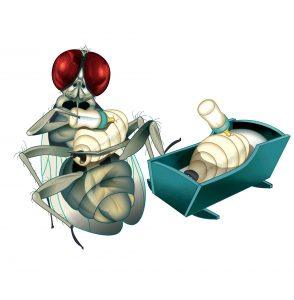Natalie Angier in The New York Times:
 Most female flies take a low-rent approach to parenthood, depositing scores of seed-sized eggs in the trash or on pet scat to hatch, leaving the larvae to fend for themselves. Not so the female tsetse fly. She gestates her young internally, one at a time, and gives birth to them live. When each extravagantly pampered offspring pulls free of her uterus after nine days, fly mother and child are pretty much the same size. “It’s the equivalent of giving birth to an 18-year-old,” said Geoffrey Attardo, an entomologist who studies tsetse flies at the University of California, Davis. The newborn tsetse fly looks like a hand grenade and moves like a Slinky, and if you squeeze it too hard the source of its plumpness becomes clear — or rather a telltale white. The larva, it seems, is just a big bag of milk. “Rupture the gut,” Dr. Attardo said, “and the milk comes spilling out.”
Most female flies take a low-rent approach to parenthood, depositing scores of seed-sized eggs in the trash or on pet scat to hatch, leaving the larvae to fend for themselves. Not so the female tsetse fly. She gestates her young internally, one at a time, and gives birth to them live. When each extravagantly pampered offspring pulls free of her uterus after nine days, fly mother and child are pretty much the same size. “It’s the equivalent of giving birth to an 18-year-old,” said Geoffrey Attardo, an entomologist who studies tsetse flies at the University of California, Davis. The newborn tsetse fly looks like a hand grenade and moves like a Slinky, and if you squeeze it too hard the source of its plumpness becomes clear — or rather a telltale white. The larva, it seems, is just a big bag of milk. “Rupture the gut,” Dr. Attardo said, “and the milk comes spilling out.”
And milk it truly is — a nutritional, biochemical and immunological designer fluid that the mother fly’s body has spun from her blood meals and pumped into her uterus, where her developing young greedily gulped it down. Thus fattened on maternal largess, a tsetse fly larva can safely burrow underground and pupate for 30 days before emerging as a full-blown adult with a nasty bite and a notorious capacity to transmit a deadly disease called sleeping sickness. In a recent chemical and genetic analysis of tsetse fly milk, Dr. Attardo and his colleagues were startled to discover how similar it was to the product of the beloved gland that stamps us as mammals. “I was expecting something completely off the wall and different,” he said. “But there are frightening, fascinating overlaps with mammalian milk in the kinds of proteins we see.”
More here.
